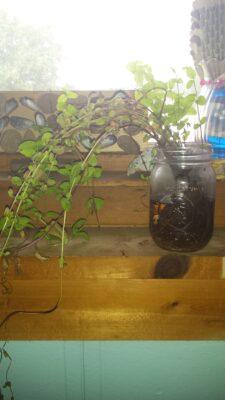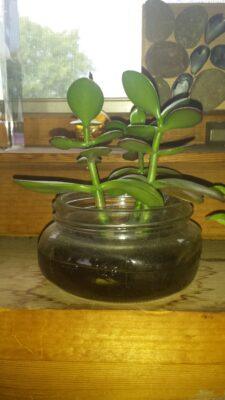Growing herbs and vegetables in the home sounds like a great idea until you think about all the mess, dirt and constant watering that must be done to grow and keep them alive.
Avoid all of this by growing them in a jar of water – without dirt! This process is a more convenient set-up that takes up little space in comparison to growing in soil. You even can grow tomatoes.
Growing vegetables and herbs in a jar has a number of benefits:
- Enhanced aesthetic quality.
- Can observe the roots growing.
- Preserved flavor.
- Less mess.
- Saves space.
- Easy to grow.
- Little watering.
- You start with cuttings, not seeds.
You will need a few things to start your plants in a jar:
- Water (rainwater or tap water left to air overnight — not chlorinated water).
- Containers (Mason jars, any glass bottles, plastic bottles). Narrow-mouthed containers are great for support.
- Plant cuttings (6-inch tips).
- Organic fertilizer
Step 1: Prep plant cuttings.
Start by removing the lower leaves from cuttings and trim the lower tips close to where the roots arise. Rinse.
Step 2: Prep container.
Clean your container well, making sure there are no chemicals in there or anything dangerous.
Step 3: Get some water.
Get some clean, fresh water. Tap water isn’t good for plants because of the trace metals and other chemicals found in it. In general, the plants will respond to it negatively. Fresh rainwater is preferred. Add organic fertilizer.
Step 4: Assemble.
- Add your cuttings to your container.
- Take your container and add your freshwater up to around the neck of the jar. The main idea is to fill it up to cover most of the stem, but you do not want to fill it up so much that it soaks the leaves. Your cuttings will rot if the leaves sit stagnant in water.
- Sit your jar in an area that either receives sun or doesn’t, depending on the sun requirements unique to your plant. Example: If you are growing mint in a jar with water, make sure to place it somewhere that receives plenty of sun!
Step 5: Maintenance.
Once you’ve assembled your plant in a jar, change the water once a week without disturbing the cuttings too much.
Looking For Non-GMO Seeds? Get Them From A Company You Can Trust!
Within 2-6 weeks, the cuttings will generally begin to grow; however, woody plants do take longer.
Herbs and Vegetables to Grow in the Water
I would argue that you can grow almost anything this way. I have even grown a succulent plant successfully in water from a tip that fell off one of my larger plants. However, you can expect higher success rates from these vegetables and herbs below.
- Mint
- Oregano
- Basil
- Sage
- Stevia
- Lemon Balm
- Thyme
- Rosemary
- Tarragon
- Lettuce
- Spinach
- Tomatoes
- Peppers
- Cucumbers
- Celery
It is so easy to grow herbs and vegetables in a simple jar of water. It’s cheap, attractive for any household, and a great source of year-round produce!
What advice would you add? What it in the section below:
Every Year, Gardeners Make This Stupid Mistake — But You Don’t Have To. Read More Here.
 Off The Grid News Better Ideas For Off The Grid Living
Off The Grid News Better Ideas For Off The Grid Living





